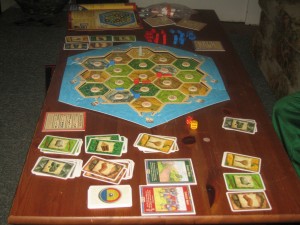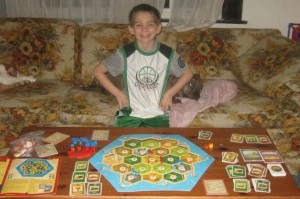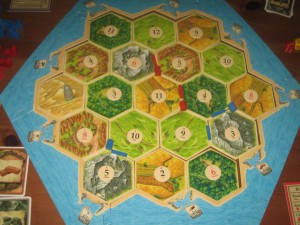I might as well dub this week, “board game week,” because I seem to be writing about them a lot lately. Oh well, it’s my blog, I can do what I want right? Anyway, I played this particular board game about two weeks ago with my ten-year old son and wanted to review it while it was still semi-fresh in my mind.
I still haven’t decided if I like it or not. There is a luck element to it that I find hard to ignore yet there is some strategy in the placement of your cities and roads, as well as the thief should you roll a seven or draw a knight development card. I suppose I should stop there and explain the game before you begin scratching your heads.
The board is broken up into hex pieces; each piece is separate from each other so that the board can be randomized in any way you’d like before the game starts. Each hex piece has a picture on it, representing a resource. There are five resources that you’ll be collecting from these hexes: wool, lumber, grain, brick, and ore. After the board is assembled (via the recommended configuration in the manual or your own custom design) you’ll place number chits on each hex. Whenever dice are rolled, players will look at the board to see which hex(es) that number represents. Players will earn resources for every settlement or city bordering that numbered hex. Resources are used to build settlements, upgrade settlements to cities, build roads, and buy development cards.
Surrounding the outside of the hexes are harbor pieces that you also have to manually assemble, again, to allow for the possibility of customization. If a player has a settlement or city bordering a harbor, they gain a bonus to resource trading with the bank. A player would normally have to give up four resources to gain one resource of his or her choice, but the harbor cuts that harsh price down to say 2:1 or 3:1. Players are thus encouraged to trade with each other, if they agree to do so.
The object of the game is to earn a set number of victory points before the other players do. Players earn victory points in a number of different ways. Building settlements or cities, having the longest road, and purchasing development cards (which have various effects) are the main ways to earn victory points.
One thing I like about Settlers of Catan is that players can earn resources on anyone’s turn. No matter who is currently rolling the dice for resources, all players earn resources depending on which number comes up and who has settlements or cities near that number.
The thief element is interesting and is pretty crippling if placed on a hex you are actively earning resources from. When a player rolls a seven, they can place the thief token on any hex they want. Anyone who rolls that number will not earn resources should they have a settlement or city bordering that hex. Moving the thief onto a hex that borders an enemy settlement or city allows that player to steal a resource card from an enemy.
I won’t go into the rules in detail, but that pretty much sums up the game…start with and place two free settlements and roads, roll for resources, build more stuff, roll for resources, build more stuff, roll for resources, occasionally move a thief, roll for resources, build more stuff, roll for resources, build more stuff, occasionally (or regularly) purchase development cards…etc etc etc.
Did I like it? I’m still on the fence as I’ve mentioned earlier. Having separate hexes and harbor pieces make the game very customizable, but the quality of the dock pieces are poor. The cardboard for the harbor pieces are warped and don’t lay flat. Unless you’re playing on a felt surface (or one which exhibits friction), bumping one hex will cause a chain reaction and cause the rest to slide under the harbor pieces on the outside. In theory, the harbor pieces are supposed to support the hexes and thus keep the playing board stable…mine do not.

If you look closely, you can see how the outside blue harbor pieces look a little warped and don’t stay flat. The hex pieces can slide right underneath if bumped.
As I’ve mentioned, the pieces are separated and must be assembled prior to play…because of this, it took about five to ten minutes for me to get the hexes and the numbers that go on them all set up. The harbor pieces refused to smooth out so I let them fold slightly and was just careful in not bumping a hex by accident.
My son and I played the game in about half and hour…turns were quick and easy, most of the time we were waiting for the dice to roll a number for a hex that bordered one of our towns…this is where the luck factor kicks in. Even though you have a greater chance of rolling a seven than you do a ten, the dice determines when you get resources. You could do the math and put your settlements near all the numbers with the best odds of being rolled but random chance can still factor into play. I’m personally not someone who likes random chance.
Overall the game is good and I’d recommend it for those that want a relatively quick to moderate resource game which has a mix of both strategy and luck. My son expressed his desire to play it again in the future, I just haven’t figured out yet if he is only saying that because he won. There are numerous expansions out there that adds more features and players to the standard two to four player game.
Final Verdict: 6/10
—
The official website has information on the game, manuals, an online version, and more:
See my Star Trek Catan review here:



Catan may not have worked so well given the base game is 3 to 4 players.